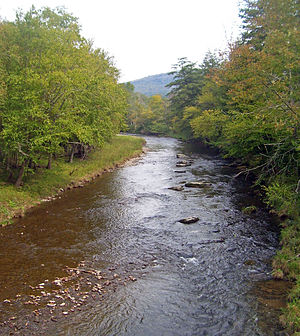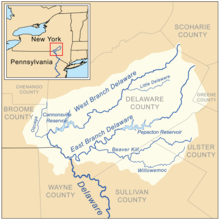| Beaver Kill | |
|---|---|
 Beaver Kill below Lew Beach | |
 Beaver Kill within the Delaware headwaters drainage basin. | |
| Location | |
| Country | United States |
| State | New York |
| Region | Catskills |
| Counties | Ulster, Sullivan, Delaware |
| Towns | Hardenburgh, Rockland, Colchester, Hancock |
| Physical characteristics | |
| Source | S of col between Graham and Doubletop mountains |
| • coordinates | 42°1′47″N 74°32′32″W / 42.02972°N 74.54222°W |
| • elevation | 2,760 ft (840 m) |
| Mouth | East Branch Delaware River |
• coordinates | 41°59′24″N 74°7′52″W / 41.99000°N 74.13111°W |
• elevation | 980 ft (300 m) |
| Length | 44 mi (71 km), NE-SW |
| Basin size | 300 sq mi (780 km2) |
| Discharge | |
| • average | 771 cu ft/s (21.8 m3/s) |
| • maximum | 62,400 cu ft/s (1,770 m3/s) |
| Basin features | |
| River system | East Branch Delaware River |
| Tributaries | |
| • left | Willowemoc Creek |
The Beaver Kill, sometimes written as the Beaverkill or Beaverkill River, is a tributary of the East Branch Delaware River, a main tributary of the Delaware River, approximately 44 miles (71 km) long, in the U.S. state of New York. The kill drains a 300-square-mile (780 km2)[1] area of the Catskill Mountains and has long been celebrated as one of the most famous trout streams in the United States. Its preservation helped establish many of the basic conservation principles of rivers in the United States.
The river has been popular as a trout stream since the early 19th century, when it became one of the first resort destinations in the United States. The subsequent depletion of the brook trout population by the 1850s led to an early conservation movement to preserve the river, including the introduction of hatcheries for brown trout. Its popularity as a trout stream arises in part from the many cold springs and deep pools in the upper river that keep the water at an even cold temperature. The fly fishing industry is centered on Roscoe, home to several fly-shops and bed and breakfasts catering to fishermen from around the world. More local fly fishing history and information can be found at the Catskill Fly Fishing Center and Museum located in Livingston Manor.
- ^ Baldigo, Barry; "Trends in Base Flows and Extreme Flows in the Beaver Kill Basin, Catskill Mountains, New York, 1915-94" (PDF).; United States Geological Survey; 1999, p. 7.